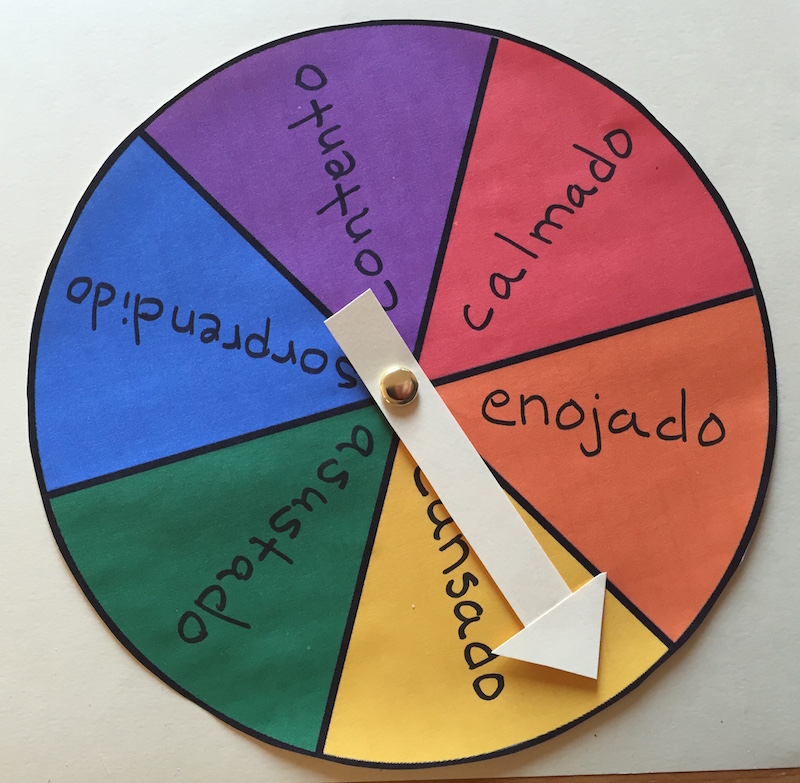5 Fun Ways to Teach Feelings in Spanish
Learning to talk about feelings in Spanish is more than acquiring new vocabulary. No one is happy all the time, and it is important for children to learn to understand and express different emotions and how they feel physically. These activities will teach children vocabulary for emotions in Spanish and help them understand how they feel.
Sing and Move
Try the free song ¿Cómo estás? Sentimientos to introduce vocabulary for feelings in Spanish. The printable lyric sheet with pictures makes the meaning of the words clear. If you want to teach a smaller set of vocabulary, use the song Estoy contento. It also has a printable lyric sheet with pictures.
Listen to the song together first, clarify new vocabulary and then sing! Once kids are familiar with the song and the vocabulary for feelings in Spanish, work together to create actions to go with the lyrics. Movement enhances language learning and makes singing along even more fun.
Emotional Eggs
Hands-on learning physically engages kids with language. Making the plastic eggs you see in the photo above is a fun way for kids to practice feelings in Spanish. For early learners, you will have to make the eggs. Older kids can help you or make their own. Making the eggs provides an opportunity to use the vocabulary repeatedly.
You can use the eggs in different ways:
- Identify the emotion on an egg.
- Try to copy the expression on the egg with your face.
- Give prompts for kids to assemble an expression: alguien que está triste, alguien que está sorprendido.
- Kids assemble a face and identify the emotion.
- Use the eggs as puppets and have them talk to each other: Me llamo Sofía. Estoy asustada.

Say It Like This
This activity is great for practicing vocabulary and also for making kids aware of their tone of voice. Practice saying phrases chorally with different emotions. Then use a spinner or a die with emotions and common phrases. Kids draw a phrase, spin an emotion and say the phrase as if they felt that way.
You can use any sentence!
Me llamo …..
Tengo que ir a casa.
No quiero comer una manzana.
¿Me puedes abrir la puerta?
¿Tienes un hermano?
Understanding Emotions
It is important to help kids make connections between feelings and situations. This is an excellent language activity because it draws on the experiences kids have every day.
First, brainstorm situations that cause different emotions. Use the situations in this video of Estoy contento or on this feelings in Spanish worksheet to get started.
Next, use the pictures on the lyric sheet of ¿Cómo estás? Sentimientos and/or from this feelings picture dictionary to make cards for the feelings in Spanish.
Use the picture cards for these activities:
- Kids listen as you describe a situation. They choose the card that represents how they would feel.
- Working in small groups, a student draws a card and without looking at it holds it on her forehead. The other students give her clues and she tries to guess which emotion she is holding.
Verb Practice with Feelings in Spanish
Play a version of I have ..Who has? using the expressions for emotions. Write the expressions you are using randomly on the board. Distribute the picture cards. The student with Estoy contento starts by saying Estoy contento/a and then choosing any other expression and asking who fits the description (¿Quién está nervioso? ¿Quién está triste? etc.) That player answers in the first person and asks about another expression.
Sorting Activities
Use categories as a quick way to have kids work with the vocabulary for feelings in Spanish or as a review. With these no-prep activities kids think about the words in different ways. For some categories, answers are subjective, so kids have to consider their own experience.
Picture cards are perfect for these activities. Kids can also do them with a word list.
Have kids sort the cards into categories. For example:
Positive feelings - Negative feelings
Physical - Emotional
Easy to talk about - Hard to talk about
Easy to recognize in someone else - Hard to recognize in someone else
Feelings that usually last - Feelings that usually are over quickly
Adjectives that show agreement - Adjectives that do not show agreement
1, 2, 3, 4, 5-syllable words
